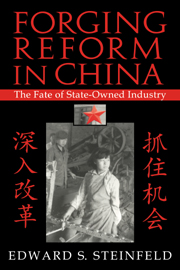Book contents
- Frontmatter
- Contents
- List of Tables and Figures
- Preface
- 1 Introduction: China's Ailing State Enterprises
- Part I Conceptual Approaches to Postsocialist Enterprise Reform
- 2 Property Rights, Privatization, and the State-Owned Firm
- 3 The Nested Problems Dynamic: An Alternative Approach
- Part II Enterprise Case Studies: The Commanding Heights in Transition
- Part III Reassessing Chinese Patterns of Economic Development
- Notes
- Bibliography
- Index
3 - The Nested Problems Dynamic: An Alternative Approach
Published online by Cambridge University Press: 12 January 2010
- Frontmatter
- Contents
- List of Tables and Figures
- Preface
- 1 Introduction: China's Ailing State Enterprises
- Part I Conceptual Approaches to Postsocialist Enterprise Reform
- 2 Property Rights, Privatization, and the State-Owned Firm
- 3 The Nested Problems Dynamic: An Alternative Approach
- Part II Enterprise Case Studies: The Commanding Heights in Transition
- Part III Reassessing Chinese Patterns of Economic Development
- Notes
- Bibliography
- Index
Summary
IN the previous chapter, we suggested that traditional property-rights analysis provides an inadequate foundation for understanding the unique processes of transitional reform. The aim of this chapter will be to begin the search for an alternative approach, an approach focusing not so much on the dissemination of rights as on the restructuring of institutional constraints on economic behavior. The overall plan of attack will be to start with the specific and then work outward to the more general. This chapter will focus on providing a new approach – the “nested problems” dynamic – for understanding the specific problem of SOE reform. The broader implications of this model for our general understanding of transitional systems will be explored in Chapter 7.
NESTED PROBLEMS AND FEEDBACK LOOPS
For large-scale Chinese SOEs, the questions that demand immediate attention are why these firms lose so much money and why they appear so resistant to market-oriented reform efforts. Answers become clearer as soon as one moves away from the question of “who owns” and toward questions of how ownership in general, and market-driven enterprise governance in particular, are undermined in the transitional context.
Chinese SOEs suffer from a particular form of corporate governance failure, a failure created by the dynamic interaction between state intervention into the firm and distorted information flowing out from the firm (see Figure 3.1). On one side of the cycle, insecure property rights – or, more precisely, the ability of state actors to override any countervailing claims of “rights” by producers – provide the context in which uncoordinated agencies of the state routinely intervene in, and extract profits from, the firm.
Information
- Type
- Chapter
- Information
- Forging Reform in ChinaThe Fate of State-Owned Industry, pp. 45 - 78Publisher: Cambridge University PressPrint publication year: 1998
